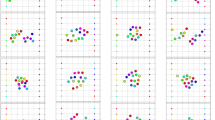Abstract
We present an efficient obstacle avoidance control algorithm for redundant manipulators using new measures called directional-collidability measure and temporal-collidability measure. Considering relative movements of manipulator links and obstacles, the directional-collidability/temporal-collidability measure is defined as the sum of inverse of predicted collision distances/times between manipulator links and obstacles. These measures are suitable for obstacle avoidance control since relative velocities between manipulator links and obstacles are as important as distances between them. Also, we present a velocity-bounded kinematic control law which allows reasonably large gain to improve the system performance. Simulation results are presented to illustrate the effectiveness of the proposed algorithm.
Similar content being viewed by others
References
Baillieul, J.: Avoiding obstacles and resolving kinematic redundancy, in: IEEE Internat. Conf. on Robotics and Automation, 1986, pp. 1698-1704.
Baillieul, J., Hollerbach, J. M., and Brochett, R.: Programming and control of kinematically redundant manipulators, in: Proc. of the 23rd Conf. on Decision and Control, 1984, pp. 768-774.
Foo, K. S., Gonzalez, R. C., and Lee, C. S. G.: Robotics: Control, Sensing, Vision and Intelligence, McGeaw-Hill, New York, 1987.
Gilbert, E. G. and Johnson, D. W.: Distance functions and their application to robot path planning in the presence of obstacles, IEEE J. Robotics Automat. 1(1) (1985), 21-30.
Gilbert, E. G., Johnson, D. W., and Keerthi, S. S.: A fast procedure for computing the distance between complex objects in three-dimensional space, IEEE J. Robotics Automat. 4(2) (1988), 193-203.
Hirose, S. and Ma, S.: Redundancy decomposition control for multi-joint manipulators, in: Proc. of IEEE Internat. Conf. on Robotics and Automation, 1989, pp. 119-124.
Hollerbach, J. M. and Suh, K. C.: Redundancy resolution of manipulators through torque optimization, IEEE J. Robotics Automat. 3(4) (1987), 308-315.
Hollerbach, J. M. and Suh, K. C.: Redundancy resolution of manipulators through torque optimization, in: Proc. of IEEE Internat. Conf. on Robotics and Automation, 1995, pp. 1016-1021.
Khatib, O.: Dynamic control of manipulator in operational space, in: Proc. of the 6th IFFToMM World Congress on Theory of Machines and Mechanisms, 1983, pp. 1128-1131.
Khatib, O.: Real-time obstacle avoidance for manipulators and mobile robots, Internat. J. Robotics Res. 5(1) (1986), 90-98.
Kircanski, M. and Vukobratovic, M.: Contribution to control of redundant robotic manipulators in an environment with obstacles, Internat. J. Robotics Res. 5(4) (1986), 112-119.
Klein, C. A. and Huang, C.: Review of pseudoinverse control for use with kinematically redundant manipulators, IEEE Trans. Systems Man Cybernet. 13(3) (1983), 245-250.
Liegeois, A.: Automatic supervisory control of the configuration and behavior of the multibody mechanism, IEEE Trans. Systems Man Cybernet. 7(12) (1977), 868-871.
Lozano-Perez, T.: Automatic planning of manipulator transfer movements, IEEE Trans. Systems Man Cybernet. 11(10) (1981), 681-698.
Ma, S., Nenchev, D., and Hirose, S.: Improving local torque optimization techniques for redundant robotic mechanisms, Internat. J. Robotic Systems 8(1) (1991), 75-91.
Maciejewski, A. A. and Klein, C. A.: Obstacle avoidance for kinematically redundant manipulators in dynamically varying environments, Internat. J. Robotics Res. 4(3) (1985), 109-117.
Mohri, A., Marushima, S., and Yamamoto, M.: Collision-free trajectory planning for manipulator using potential function, in: IEEE Internat. Conf. on Robotics and Automation, 1995, pp. 3069-3074.
Nakamura, Y., Hanafusa, H., and Yoshikawa, T.: Task-priority bassed on redundant control of robot manipulators, Internat. J. Robotics Res. 6(2) (1987), 3-15.
Rahmanian-Shari, N. and Troch, I.: Collision-avoidance control for redundant articulated robots, Robotica 13 (1995), 159-168.
Wu, C. J.: On the representation and collision detection of robots, J. Intelligent Robotic Systems 16 (1996), 151-168.
Yoshikawa, T.: Manipulability of robot mechanism, Internat. J. Robotics Res. 4(2) (1985), 3-9.
Author information
Authors and Affiliations
Rights and permissions
About this article
Cite this article
Choi, S.I., Kim, B.K. Obstacle Avoidance for Redundant Manipulators Using Directional-Collidability/ Temporal-Collidability Measure. Journal of Intelligent and Robotic Systems 28, 213–229 (2000). https://doi.org/10.1023/A:1008131702701
Issue Date:
DOI: https://doi.org/10.1023/A:1008131702701




